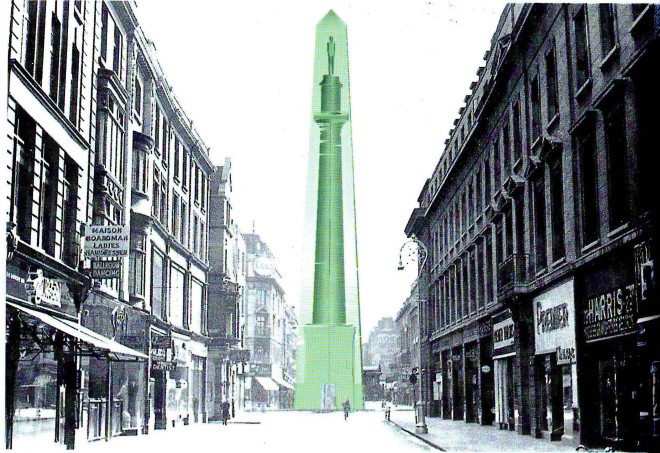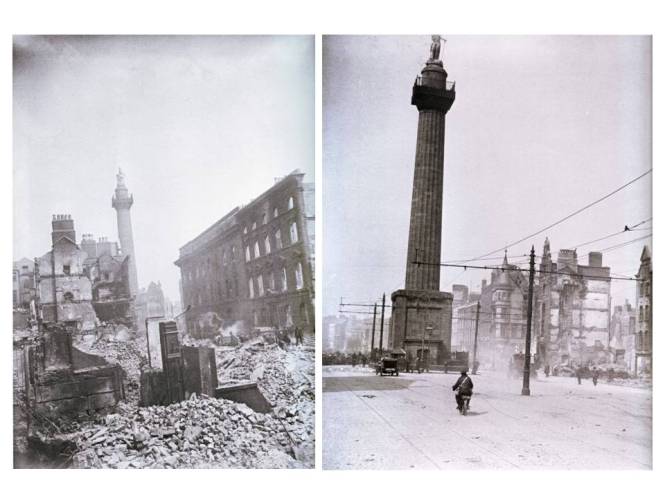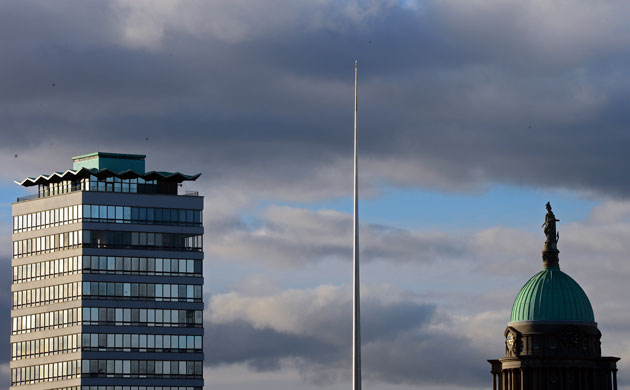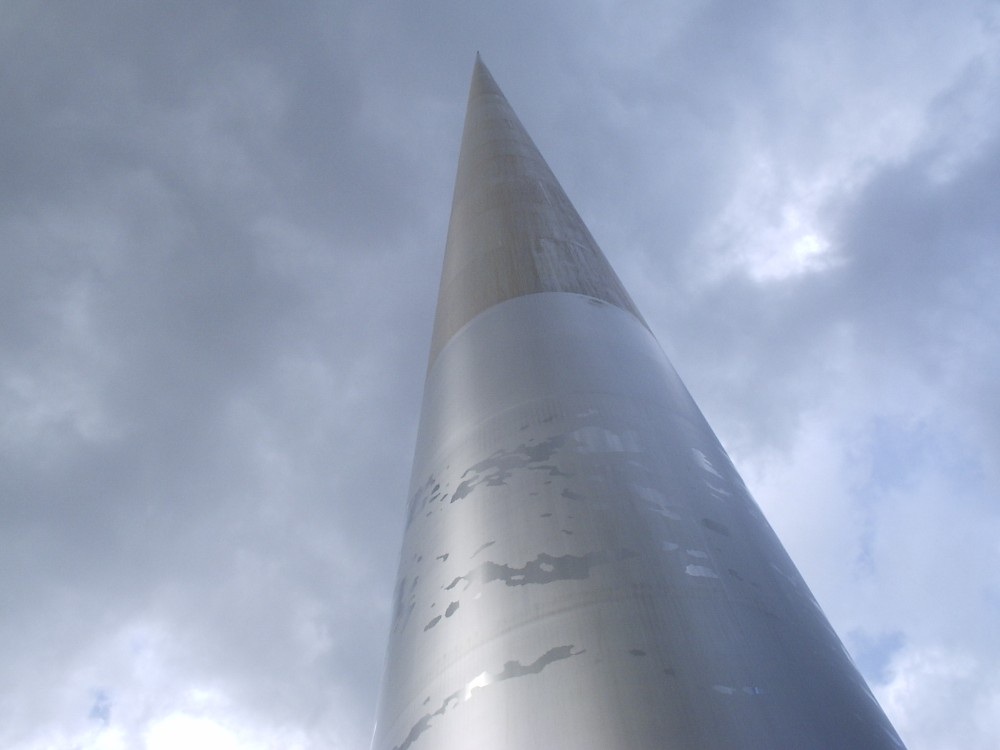The monument is a legitimising institution designed to naturalise the concept of ‘collective memory’ and shape discourses of public space. While monuments are used to represent specific narratives of authority and history, they also function as discursive sites at the intersection between ‘official’ and ‘unofficial’ memory narratives.
Sites of Memory
A short promo for RTE television serves to show how the concept of a ‘site of memory’ is a regular and effective tool to reinforce national identity. In an aureate Dublin, Nelson’s Pillar elongates and soars, morphing into the Millennium Spire. The symbolism of achievement is clear: the movement, swift and continuous; the transformation, inevitable. An image of a dynamic, foreword-looking, self-confident European capital is successfully promoted. But what is left out of this vision? The violence, both symbolic and actual, of the removal and the four decades of awkward absence that lay at what had once been the social and economic heart of the city.
Collective memory, then, can be understood as a cultural process of interpretation and transmission whereby, as Edward Said phrases it, ‘past events are selected, reconstructed, maintained, modified and endowed with political meaning’.[1] It is not so much a form of knowledge of the past as a pattern of remembering and forgetting. The sense of a shared past is a claim of continuity with a historic community and a key strategy in the formation and articulation of a national identity. However, in the same way that individual memory sustains identity narratives that are in the process of being lived through (and are, therefore, necessarily incomplete), national memory is a construct dependant on the mediation of narratives that focus on the nation or the nation-to-be that are also subject to constant reinterpretation and are equally as fluid.
Pierre Nora distinguishes between ‘sites of memory’ and the ‘medium of memory’; a ‘site of memory’ is where memory is crystallised in physical form, such as a monument or memorial; the ‘medium of memory’ is the social environment in which memory is experienced as ‘living reality’, or an everyday part of life. In his analysis, memory and identity are only made available within social and cultural frameworks and, as such,
‘…the less memory is experienced from the inside the more it exists through its exterior scaffolding and outward signs.’[2]
In other words, sites of memory are not evidence of continuity with the past, but rather emerge because of a break in ‘the imaginative grasp of continuity.’[3] This scheme is highly relevant to the two designs under discussion; each, to differing ends, addresses the historic and symbolic context of the site.
The premise that a monument represents a form of ‘memory work’ or moral obligation to contemplate the past involves two modes of inscription: from the top down and from the bottom up. On one hand, normative ideas and values can make sense of personal and transmitted memory narratives to reinforce, reproduce and mobilise a sense of ‘national memory’. On the other hand, the dissonance between the official narratives promoted by ‘sites of memory’ and unofficial, alternative readings can be deeply felt, often to the extent that monuments become a target for symbolic negation or actual violence. For example, the blowing up of the statue of Nelson in 1966, the fiftieth commemorative year of the 1916 Rising, was, in one sense, a symbolic act of keeping faith with, and claiming ownership of, republican tradition, and in another sense, a literal re-enactment of the three failed attempts to blow up Nelson’s Pillar during the Rising. Yet, even after the symbolic de-colonisation process of removal and renaming that followed Independence, Nelson’s Pillar had remained a symbol of continuity, both as a distinctive landmark and as an established framing device that echoed and enhanced the Daniel O’Connell Monument. Most notably, it is a potent presence in photographs of the aftermath of 1916, rising out of the rubble or as a viewpoint for looking down upon the destruction. Nelson’s Pillar, it seems, could both signify modern Dublin and British rule. One image contains that tension at a breaking point; the Column remains monumental, the figure of Nelson, however, is decapitated by the framing edge.
While, monuments can serve an integrative function, the very attempt to give concrete expression to a single vision of the past signals that it is not, in fact, sustained within the ‘medium of memory’. Put simply, ‘sites of memory’ have different interpretive communities; certainly, interpretations of Nelson’s Pillar and its fate have hinged on Dublin’s ambiguous status as the second city of Empire, variously presented as colonial subject or imperial partner. In response to the politics of commemoration and informed by the de-constructivist insight that a master-narrative contains its own counter-discourses, a strategy of ‘counter-monument’ has developed within the discourse of contemporary public art. It acknowledges the impossibility of unifying discordant memories and instead seeks to debate the ethics and agendas of ‘memory management’ and ultimately, it has been argued, to ‘challenge the status of memory as a knowable object’.[4]
Monument to Memory
Monument to Memory, designed by the Irish architect Jonathan Bennett, was short-listed in the 1998 competition organised by the Royal Institute of the Architects of Ireland and Dublin Corporation for a monument for the Nelson’s Pillar site in Dublin. It called for the core of a layered glass obelisk to be hollowed out by computer-guided laser to create the negative form of the Nelson memorial. This metonymic ‘inversion’ or ‘translation’ from mass to volume reveals a self-consciousness about the traditional rhetoric of public monuments; the gendered architectural language connected with the victory column is a case in point. Its massive scale, vertical thrust, and, in particular, the choice of ‘unadorned’ Doric order were understood as representations of masculinity. In Bennett’s design an entrance opening into the interior space would have allowed viewers to experience the void within the obelisk. From inside, the towering volume is subversive of the rhetoric of mastery; Nelson is disembodied; the hybrid of two phallic monuments becomes an empty prophylactic sheath. From outside, the historic tensions between competing identities in Ireland and the ideological opposition of coloniser and colonised appear to be held in ‘holographic’ suspension.

The work explicitly engages with the concept of memory; however, the title refers to an abstract category rather than a specific event or individual (and by extension, defined identity). The ‘Memory’ acknowledged is both that of the original monument and that of its absence. So, if Monument to Memory can’t be read in terms of nostalgia for an unchallenged imperial order, is it a depoliticised ‘musealisation’? One must bear in mind that for many Dubliners Nelson’s Pillar had been a familiar presence, naturalised as a landmark and embedded into the fabric of the city; something assimilated through use and language as a symbol of modernity and civic identity. The effect of the presentational image, superimposing the proposed monument upon an archival photograph of the site, is to remind one of just how the names and dates of Nelson’s military victories on the base must have been juxtaposed with signs advertising ballroom dancing, dentistry and hairdressing. In this way its official messages had become contingent, if not entirely ‘invisible’. It becomes clear that the ‘memory work’ being asked of contemporary viewers is ambiguous, provisional and layered. I would argue that this is a strategic attempt to shape memory of the colonial heritage as a ‘sphere of ambiguity, tension, transition, hybridity, between “national” and “imperial” spheres’.[5]
The project would have reintroduced a major element into the symbolic sequence of O’Connell Street that was used to confirm a nationalist meta-narrative, but in such a way as to historicise it. In an essay on monument/memory, James Young uses the metaphor of surface reflection to describe how ‘the tempestuous, social, political and aesthetic forces’ at play in uses of the past are ‘normally hidden by a monument’s taciturn exterior’.[6] In this context, the play of looking in and out and, indeed, through in Monument to Memory can be double-coded; referring to the ‘everyday’ social use of memory in mediating and shaping cultural identities, and to the ‘unavailable’ past enclosed in the glass display case of the museum, distant or ‘untranslatable’.

The success of ‘site-specific’ artwork lies in its mode of address to public space: is it appropriated as ‘spectacular street furniture’ or can it offer some critical purchase on the site?[7] Tellingly, the jury’s description of the successful design praised the refusal of the Welsh architect, Ian Ritchie, to look back at a ‘native historical secret’.[8] This cannot but be interpreted as a reference to their reading of Jonathan Bennett’s design. In the jury’s description of their consideration of its merits, the nub of the question was the relevance of Nelson to modern Dublin. In a very important sense they missed the point: far from being ‘overly referential’ as it was criticised, one of the strengths of Bennett’s design is that it was not an explicit commemoration. Meaning is not fixed by text on a plaque; instead, it could be produced through the projection of a symbolic language of coloured light through the reflective and refractive core. Possibilities suggested in the proposal included red for World AIDS day and green for St. Patrick’s day. As contemporary notions of ‘Irishness’ are contested along new axes of differentiation, such semiotic friction between signifier and signified could have proved an elegant and productive reminder of the relational and multiple nature of identities. However, the jury’s unspoken assumption was that this discursive exploration of the monument form would have been a constraint on the reinvention of Dublin as a more attractive consumer and cultural centre.
Monument to Light
A common critical response to the winning entry, Monument to Light, was to relate its design with the culture of contemporary Ireland: one such comment was that the monument might have
‘[no] specific meaning in its own right… it’s not religious, it’s not military, it’s not political…but it does say something about wealth.’.[9]
A counter-argument was that it embodied a collective civic consciousness in the abstract sense of aspiration, and also, literally, in its ‘democratic’ and ‘rational’ relation to space, namely its ‘ability to occupy the most important civic space without oppressively dominating it’.[10] Jury member and sculptor, Vivienne Roche noted that ‘it will stand within the street, be part of it, lifting rather than weighting its surroundings’. [11] Ritchie also located his design in a discourse of urbanism, acting as a point of orientation throughout the city, providing clear sight lines at the intersection of Henry Street and Talbot Street, and an axial marker for O’Connell Street. The ideas of Aldo Rossi of the monument as a ‘freed point in the urban dynamic’ were key in the thinking of designer and jury.[12] In fact, the Rossi quotation included in Raymund Ryan’s essay The Monument in the City, published for the launch of the competition, was quoted back in the Richie proposal.
In keeping with a modernist ideal of purity and universality, Ritchie claimed the pre-eminent virtues of his design were its integrity and rigour; it was, in his words, ‘ideologically Teflon’ having rejected the temptation of the all too easy signification that it might have had had it had carried, for example, ‘the stars of the European Union or the names of Irish martyrs’. [13] It was framed as an apolitical, autonomous artwork, ‘more concerned with the manipulation of space itself than with representing things within it.’[14] If Monument to Light could be constructed as an escape from history it could not do so with out contradiction. For example, setting out the origin of his design, Ritchie describes how his challenge was to connect ‘ground and sky, past and future’. [15] Such was his enthusiasm for the formal elegance and innovative engineering of the project, that almost every essentialised cliché of Irish memory and identity is then pitched to justify the statement.
Starting with the base, the cast-bronze spiral is apparently inspired by Celtic metalwork and New Grange stone carvings. Moving up to the surface pattern of the lower frustules, which is abstracted from a geological core sample taken when laying the foundation platform, Richie then suggests a further lyrical reading: ‘as mirrored seas or lakes, or …as hundreds of islands floating in a mirrored sea.’ [16] This represents an imagistic shift from the concept of connection to land and site to ‘ideas of scattering and of ebb and flow’, which he argues is an engagement with the memory of historic emigration and the reality of contemporary immigration. Turning to the material qualities of the polished stainless steel, chosen to reflect the ‘constantly changing subtleties of light, cloud and mist’, Ritchie hits upon the environmental determinism that is one of the enduring characterisations of poetic ‘Irishness’. In the morphology set out by Ryan, the form itself is inspired by timeless, elemental standing stones, by way of ‘the blade-like obelisk [of the Wellington Testimonial]’ and in further contrast to ‘the static column [of Nelson’s Pillar]’. [17]
To be fair, the very real strengths of the design come from a deliberate openness to different readings. Certainly, as described by Ryan, ‘its elemental shape and allegories of illumination’ have an universal resonance, that can also be culturally coded as symbolising the hopes and ambitions engendered in Ireland at the turn of the Millennium by the Peace Process and economic boom.[18] Richie’s enthusiastic iconographic exegesis encourages a celebratory account of the history of the Irish people from ‘Celtic Creativity’ to ‘Irish Diaspora’ to ‘Ireland of the Future’. What has been missed, however, is an opportunity to do more than piggyback on ideas of collective memory and national identity, which is to make them comprehensible as complex, historically formed relationships.
The strength of Bennett’s reflexive design is that, instead of attempting to simultaneously repress and transcend the contested meanings of the Nelson’s Pillar site, it facilitates the critical examination of the cultural circuit in which such meanings are produced, reproduced and continuously revised.



